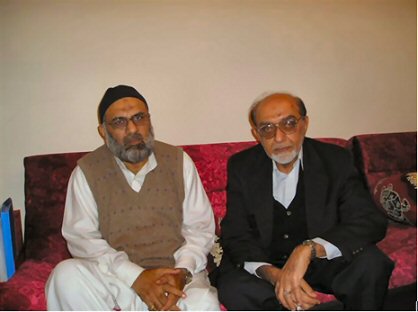|

|
|
Hassan Jaffer (right) with Maulana Zaffer Abbas |
The Khoja Shia Ithna-Asheri community, as an ethnic entity, are at a cross roads today. They are fast becoming an endangered species with reactionary drift to no-where.
Societies that know little of their origin and their history are often at a loss to draw lessons from their past. As a result they tend to get confused and find it difficult to chart their course in troubled waters.
Fifty years down the line the Khoja community, as we know of them today, will virtually cease to exist as such. This is particularly true of the communities settled in the West, the Far East and to a great extent in Africa also. The communities in India and Pakistan, because of their greater number and the environment they are living in, may not recognize the imminent danger. Similar dynamics apply to them also and it may take a little longer to register.
While the loss of the ethnic identity only may be tolerable, can the community afford to accept the loss of the purpose for which they came into being as a particular ethnic and religious society in the first place?
There is nothing great at being a Khoja Shia Ithna-Asheri except for one thing. At one stage in their history, they had put on their thinking cap and raised questions. It is this spirit of inquiry, coupled with the willingness to ask bold questions and, more than that, having recognized their shortcomings, their courage in taking a stand, against many odds, led to the emergence of the Khoja Shia Ithna-Asheri Muslim community as we know of them today.
Proclamation of the particular ethnic identity and evolution of the related structured community organizations put in place in their wake, were solely motivated by a burning desire to preserve and promote the faith of their choice. They used this ethnic structured vehicle effectively to achieve their objective. Over the past century, this approach has served the community well. The same vehicle of the community structures can now be effectively harnessed to address to the growing challenges ahead.
Is the same spirit of inquiry and willingness to adapt to the current realities alive today? Can the Khoja community survive as practicing Shia Ithna-Asheri community by simply maintaining the status quo and try to re-live their past?
The dynamics have changed. Khoja are no more living in sheltered environments of the Indian sub continent or in the colonial days in Africa.
Over the past century, the institution of the home-grown Mulla has commendably nurtured the community in India and in Africa. To a variable degree, this institution of Mulla has also served the community in the West. The 120,000 odd Khoja spread all over the world owe a debt of gratitude to them.
Current realities however call for the training of Ulema who are also conversant with the modern academic educational systems and are thus able to relate to the present realties. With specialized competence, they need to be able to effectively interact and communicate with the growing generation born and bred in the West.
Western influence is all pervasive. In fact, in terms of the prevailing environments, even the East can now be described as outposts of the Western outlook. This is the hard reality.
The institutions oaf Madaris and Hawze Ilmiyya operating in the Middle East and in the Indian subcontinent are essentially geared to address to the local nationalistic needs. They are slow to recognize local and global challenges. So far they have not been able to adapt themselves to address to the needs of the distant communities settled in various parts of the world. In several such institutions, reforms may be underway, but they are slow to materialize.
As a community we have an obligation to our own progeny to uphold the objective for which we came into being as a community in the first place. Inaction is not the best way forward. Are we supposed to relegate that responsibility to others and wait for the good day when our needs would be eventually met without any effort on our part?
Establishment of the Islamic Institute of Postgraduate Studies in Sayyida Zainab, Damascus, is the need of the time. It is a along overdue step in the right direction.
We need to produce modern educated and enlightened individuals to emerge as Islamic scholars who blend into the society they live with and effectively serve in the way of Allah.
Such individuals trained with the combined madaris and the hawza system blended in with the modern University education system is the ideal approach. In fact, there are others too who have started thinking on similar lines. Ours is a small endeavour - a drop in the ocean. But we have taken an initiative and set the trend. It is to be hoped that many will profit from our experience and the outlook will grow as a result.
Initially there would of course be some limitations and shortcomings. Which institutions have emerged as perfect models from day one? Have the intuitions of Lucknow, Qom and Najaf, Cambridge and Oxford catapulted as ideal models overnight? Are they all perfect models today without any need for further adaptation?
The World Federation deserves to be congratulated for taking this initiative. May Allah in His Mercy bless this endevaour with all the barakaat. Amin.
Hassan Ali M. Jaffer
Mombasa, Kenya
7 September 2007